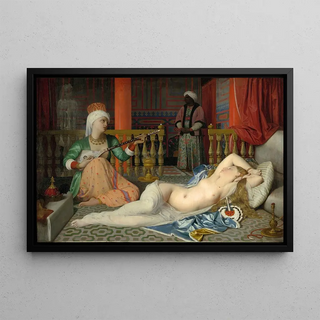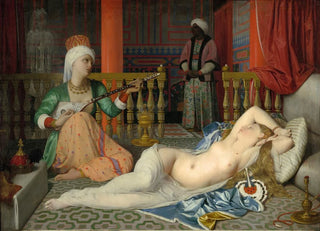Art print | L'Odalisque à l'esclave - Jean-Auguste-Dominique Ingres


View from behind

Frame (optional)
An elegant scene of the Orient
Created in 1839, L’Odalisque à l’esclave illustrates Ingres's interest in oriental themes, very fashionable during the Romantic era. It depicts a woman reclining on a divan, surrounded by silky draperies, listening to a slave playing the lute.
The artist combines sensuality and restraint: the female body, of unreal grace, is highlighted by the purity of the line and the delicacy of warm tones. The light glides over the model’s nacreous skin, creating an atmosphere that is both intimate and majestic.
Every detail — the fabrics, jewelry, music, and arabesques of the decor — transports the viewer to a dreamed-of Orient, a symbol of exoticism and refinement.
The perfection of line according to Ingres
For Ingres, drawing is the foundation of everything. In L’Odalisque à l’esclave, each line seems designed to celebrate the beauty of the body and the softness of curves.
The artist, trained in classical rigor, blends a discreet sensuality that breaks with realism. He does not seek to represent nature as it is, but as it should be: perfect.
The result is a work of rare harmony, where each form balances with almost musical precision. This pursuit of purity has inspired many modern artists, from Matisse to Picasso.
A timeless work for your decor
Choosing an art print of L’Odalisque à l’esclave is inviting a fragment of French art history into your home. Its visual balance and warm palette make it an ideal piece for an elegant living room, a refined bedroom, or a calming reading space.
Hanged on a light wall, this poster evokes calm, voluptuousness, and the timeless beauty of classicism. It complements both modern interiors and more traditional decor.
About the artist
Jean-Auguste-Dominique Ingres (1780–1867) is one of the undisputed masters of French classicism. A student of David, he established himself with drawing of absolute purity and a constant pursuit of ideal beauty. His most famous works, such as La Grande Odalisque, La Source, or Le Bain turc, combine sensuality, rigor, and harmony.
With L’Odalisque à l’esclave, he signs one of his most emblematic compositions, where subtle eroticism and perfection of line meet.

Matte finish

View from behind

Frame (optional)
An elegant scene of the Orient
Created in 1839, L’Odalisque à l’esclave illustrates Ingres's interest in oriental themes, very fashionable during the Romantic era. It depicts a woman reclining on a divan, surrounded by silky draperies, listening to a slave playing the lute.
The artist combines sensuality and restraint: the female body, of unreal grace, is highlighted by the purity of the line and the delicacy of warm tones. The light glides over the model’s nacreous skin, creating an atmosphere that is both intimate and majestic.
Every detail — the fabrics, jewelry, music, and arabesques of the decor — transports the viewer to a dreamed-of Orient, a symbol of exoticism and refinement.
The perfection of line according to Ingres
For Ingres, drawing is the foundation of everything. In L’Odalisque à l’esclave, each line seems designed to celebrate the beauty of the body and the softness of curves.
The artist, trained in classical rigor, blends a discreet sensuality that breaks with realism. He does not seek to represent nature as it is, but as it should be: perfect.
The result is a work of rare harmony, where each form balances with almost musical precision. This pursuit of purity has inspired many modern artists, from Matisse to Picasso.
A timeless work for your decor
Choosing an art print of L’Odalisque à l’esclave is inviting a fragment of French art history into your home. Its visual balance and warm palette make it an ideal piece for an elegant living room, a refined bedroom, or a calming reading space.
Hanged on a light wall, this poster evokes calm, voluptuousness, and the timeless beauty of classicism. It complements both modern interiors and more traditional decor.
About the artist
Jean-Auguste-Dominique Ingres (1780–1867) is one of the undisputed masters of French classicism. A student of David, he established himself with drawing of absolute purity and a constant pursuit of ideal beauty. His most famous works, such as La Grande Odalisque, La Source, or Le Bain turc, combine sensuality, rigor, and harmony.
With L’Odalisque à l’esclave, he signs one of his most emblematic compositions, where subtle eroticism and perfection of line meet.






